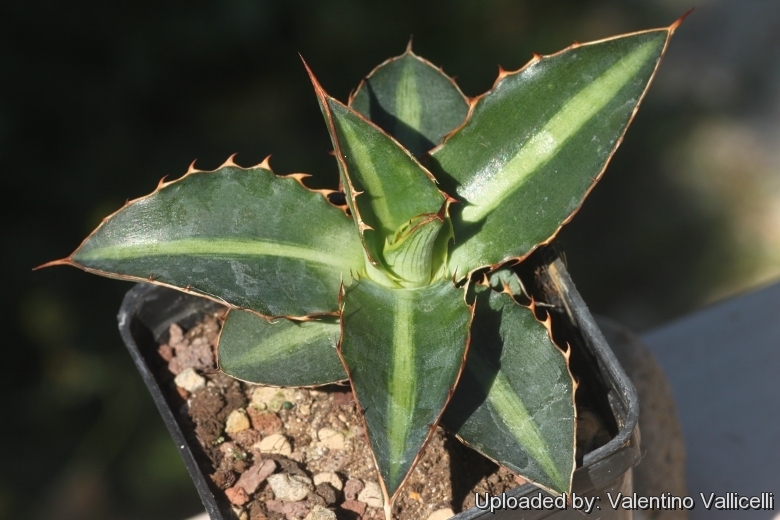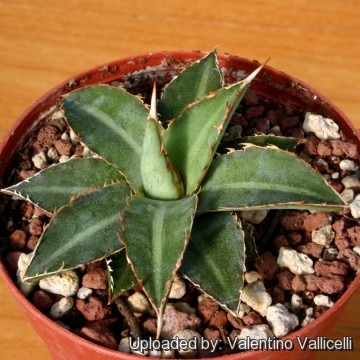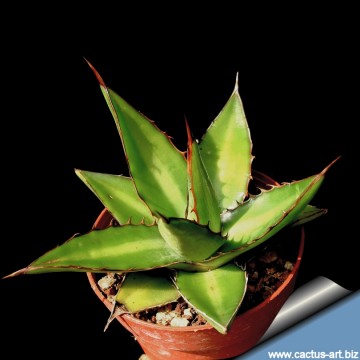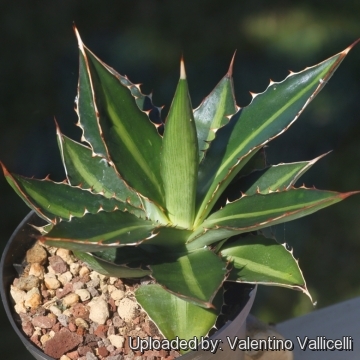Accepted Scientific Name: Agave triangularis Jacobi
Zweiter Nachtrag zu dem Versuch Einer Systematischen Ordnung der Agaveen 149, 1869. et: in C. Koch & Fint. Wochenschr. xii. (1869) 178. Jacobi

Agave horrida var. triangularis (Agave triangularis) Photo by: Valentino Vallicelli
Origin and Habitat: Mexico (Puebla, Oaxaca)
Habitat: Common on the arid calcareous mesa west of Tehuacan in southern Puebla, in heavily grazed areas with stony ground and tree forms of Yucca periculosaSN|29988]]SN|29988]] and Lysiloma sp. Here also are numerous tree cactus and several other agaves. This table land is 1650 to 1950 m elevation with 475-500 mm of rain, annual .The winters are dry and frostless.
Synonyms:
See all synonyms of Agave triangularis
back
Accepted name in llifle Database:Agave triangularis JacobiZweiter Nachtrag zu dem Versuch Einer Systematischen Ordnung der Agaveen 149, 1869. et: in C. Koch & Fint. Wochenschr. xii. (1869) 178.Synonymy: 5
back
Description: Up to 50-80(-100) cm. Slow-growing, short-stemmed, widely surculose, seldom flowering, rigid rosettes, forming open clones; When this agave matures, its leaves are stout, and clustered together, creating a starburst effect.
Leaves: Olive-green, light yellowish green or bright apple-green or finely flecked with brownish red, finely asperous with a broad yellowish band running down the center of each leaf., mature leaves deltoid-lanceolate (dagger-shaped) 30-60 x 5-7 (mid-leaf) cm, rigid, thick at base, concavo-convex, straight, When stressed by drought and cool weather, the leaves turn shades of red. Leaves are variable in size and shape. Margin corneous continuous, 1-2 mm wide, grayish, straight, with or without teeth, the teeth small, few (2-3 mm long), and remote (3-5 cm apart), or large, 5-9 mm long, 1-2 cm apart, gray, straight or curved. Terminal spine 2-4 cm cm long, conical to subulate, usually straight, grayish, grooved above, somewhat keeled below.
Remarks: This taxon is recognizable by its thick, rigid, deltoid, olivaceous leaves. Toothless forms are also common. The leaves of this species are quite variable depending on clones
 Agave horrida var. triangularis (Agave triangularis) Photo by: Valentino Vallicelli
Agave horrida var. triangularis (Agave triangularis) Photo by: Valentino Vallicelli Agave horrida var. triangularis (Agave triangularis) Photo by: Cactus Art
Agave horrida var. triangularis (Agave triangularis) Photo by: Cactus Art Agave triangularis (Agave triangularis) Photo by: Valentino Vallicelli
Agave triangularis (Agave triangularis) Photo by: Valentino Vallicelli Agave horrida var. triangularis (Agave triangularis) Photo by: Valentino Vallicelli
Agave horrida var. triangularis (Agave triangularis) Photo by: Valentino VallicelliCultivation and Propagation: Agave triangularisSN|579]]SN|579]] is a relatively easy-to-grow species. Need a very well-drained, soil. It is theoretically hardy to -7° C , particularly when dry . It grows fairly fast in summer if provided with copious water but allows to dry thoroughly before watering again. During the winter months, one should only water enough to keep the leaves from shrivelling. They do well in full sun or a lightly shaded area. Plants cultivated outdoors are drought tolerant and takes blasting heat and full sun.
Propagation: By suckers which often are found growing around the base of the plant, Remove the basal suckers (if available) in spring or summer and let the cuttings dry for a few days before inserting in compost or by seed.














